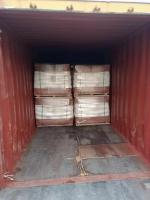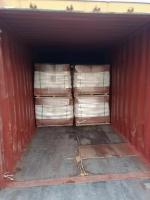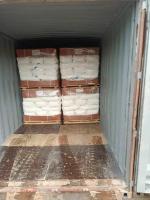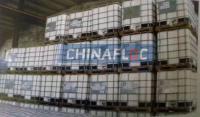Our Products
Polyacrylamide / Cationic polyacrylamide of zetag 9266FS can be replaced by Chinafloc C

Cationic polyacrylamide of zetag 9266FS can be replaced by Chinafloc C
Cationic polyacrylamide (CPAM) with medium charge density is a versatile polymer used in various industrial applications, especially those involving water treatment, sludge dewatering, papermaking, and mining. The medium charge density allows CPAM to balance its reactivity with both highly anionic and less charged substances, making it a suitable choice for handling a wide range of particles and pollutants.
How Cationic Polyacrylamide Works
Cationic polyacrylamide, particularly with medium charge density, operates through several fundamental mechanisms:
Charge Neutralization: Many suspended particles in water, especially organic matter and colloids, carry negative charges, which cause them to repel each other and remain stable in the suspension. CPAM with medium charge density neutralizes these negative charges, allowing the particles to come together and form larger aggregates, or flocs. These flocs are easier to remove via sedimentation, filtration, or centrifugation.
Bridging Mechanism: The polymer chains of CPAM adsorb onto the surface of different particles, effectively linking them together. This “bridging” process enhances the flocculation effect, helping to form larger and more stable flocs. The length and structure of the polymer chain, along with the medium charge density, determine how well CPAM can bind to particles and promote flocculation.
Electrostatic Attraction: The cationic charge in CPAM interacts with negatively charged surfaces, including natural organic matter (NOM) and inorganic contaminants like clays or silts. CPAM's medium charge density allows it to work efficiently in various pH and ionic conditions, making it a flexible choice in different water treatment systems.
Hydrophobic and Hydrophilic Interactions: Depending on its specific chemical structure, CPAM can exhibit hydrophilic (water-attracting) or hydrophobic (water-repelling) interactions. This characteristic helps the polymer target a variety of contaminants, including both organic and inorganic pollutants. CPAM with medium charge density strikes a balance, offering effective interaction with substances in complex mixtures, such as wastewater streams containing both organic and inorganic impurities.
Main Applications of Cationic Polyacrylamide with Medium Charge Density
The balanced charge density of CPAM makes it suitable for a wide array of applications across multiple industries. The most prominent sectors that benefit from medium-charge CPAM include water treatment, sludge dewatering, papermaking, and various industrial processes.
1. Water and Wastewater Treatment
One of the primary uses of cationic polyacrylamide, particularly those with medium charge density, is in water and wastewater treatment processes. Its ability to neutralize negative charges and promote flocculation makes it indispensable in both municipal and industrial water treatment plants.
Municipal Wastewater Treatment: In municipal wastewater treatment facilities, CPAM is used to improve the removal of suspended solids, organic matter, and nutrients like phosphorus and nitrogen. Wastewater typically contains a variety of colloidal and particulate matter that resists settling. CPAM, through flocculation, aggregates these fine particles into larger flocs that can be more easily separated from the water. The medium charge density helps CPAM work efficiently in a range of conditions, including varying levels of organic and inorganic contaminants.
CPAM is particularly useful during the secondary clarification stage, where biological flocs formed in biological treatment processes are aggregated for removal. It also helps improve the sludge settling characteristics, allowing better separation of water and solids.
Industrial Wastewater Treatment: In industries such as textiles, petrochemicals, mining, and food processing, CPAM plays a key role in removing oils, grease, suspended solids, and heavy metals from process water. The medium charge density allows CPAM to flocculate a wide variety of contaminants without the need for excessive dosing, thus making it cost-effective and efficient.
CPAM is often used in combination with other coagulants like alum, ferric chloride, or polyaluminum chloride to enhance the overall treatment process. In industrial wastewater applications, its flexibility allows it to treat both organic-rich and inorganic-rich waste streams effectively.
2. Sludge Dewatering
Sludge dewatering is another major application of CPAM with medium charge density. The polymer is used to enhance the solid-liquid separation process, which reduces the volume of sludge and facilitates easier handling and disposal.
Municipal Sludge Dewatering: Municipal wastewater treatment plants produce significant amounts of sludge during the treatment process. This sludge consists of water, organic matter, and suspended solids. CPAM is added to the sludge before mechanical dewatering processes (such as centrifugation, belt filter presses, or screw presses) to promote the formation of larger, stronger flocs, which can then be separated from the water.
The use of CPAM with medium charge density is particularly advantageous because it helps in achieving an optimal balance between the polymer dose and sludge dewatering efficiency. Too much polymer can lead to operational issues, while too little may result in poor dewatering performance. The medium charge density ensures that the polymer interacts effectively with the sludge particles without over-dosing.
Industrial Sludge Dewatering: Industrial processes, such as those in the food and beverage, pulp and paper, and chemical industries, also generate sludge that requires dewatering. CPAM with medium charge density is used to improve the dewaterability of sludge in these industries. The polymer's ability to flocculate both organic and inorganic matter makes it suitable for use in diverse sludge types. In mining, for example, it is used to dewater mineral slurries, improving water recovery and reducing tailings volumes.
3. Papermaking
Cationic polyacrylamide with medium charge density plays an important role in the papermaking industry, where it is used as a retention aid, drainage aid, and dry strength enhancer.
Retention Aid: CPAM is used in the papermaking process to retain fine particles, fibers, and fillers within the paper sheet. The cationic nature of the polymer allows it to neutralize the negative charges on fibers and fillers, promoting their retention in the paper matrix. This improves the efficiency of the papermaking process by reducing the loss of valuable materials in the white water (the water drained from the paper during formation).
The medium charge density of CPAM helps strike a balance between charge neutralization and polymer interaction with the fibers, ensuring that the retention aid works effectively without over-flocculating the fibers, which could reduce paper quality.
Drainage Aid: CPAM also acts as a drainage aid, promoting faster removal of water from the paper sheet during formation. This helps increase the production speed of the paper machine and reduces the energy required for drying the paper. The medium charge density ensures that the polymer interacts appropriately with both the fibers and the fillers, allowing for efficient water removal without negatively affecting sheet formation.
Dry Strength Additive: In papermaking, CPAM is used to enhance the dry strength of the paper by improving the bonding between fibers. The polymer’s positive charge allows it to form hydrogen bonds with the cellulose fibers, increasing the tensile strength of the paper. CPAM with medium charge density is especially useful in producing paper products that require higher strength, such as packaging materials, tissue paper, and printing paper.
4. Mining and Mineral Processing
Cationic polyacrylamide with medium charge density finds important applications in mining and mineral processing, where it is used to improve solid-liquid separation processes and enhance the efficiency of mineral recovery.
Flocculation in Mineral Processing: In mining, CPAM is used in the flotation process to promote the separation of valuable minerals from gangue material. CPAM’s ability to flocculate fine particles is critical in this process, where it helps to aggregate the fine mineral particles and enhance their recovery. Medium-charge CPAM is especially effective in treating slurries that contain both organic and inorganic materials, making it suitable for use in a variety of mineral processing applications.
Tailings Dewatering: After the extraction of valuable minerals, the remaining material, known as tailings, must be managed and often dewatered before disposal. CPAM is used to promote the settlement and dewatering of tailings, improving water recovery and reducing the environmental impact of mining operations. The medium charge density of CPAM ensures effective flocculation of fine tailings particles without requiring excessive polymer dosing.
5. Textile Industry
In the textile industry, CPAM is used for water treatment and effluent management. Textile manufacturing produces a large volume of wastewater that contains dyes, chemicals, and suspended solids. CPAM helps in the removal of these contaminants by flocculating the suspended solids and promoting their removal through sedimentation or filtration.
Dye and Chemical Removal: The wastewater from textile mills often contains dyes and other chemicals that are difficult to remove using conventional methods. CPAM with medium charge density can effectively interact with these anionic substances, promoting their aggregation and removal from the wastewater. This improves the clarity of the treated water and reduces the environmental impact of textile effluent.
Effluent Treatment: Textile effluents can be highly variable in composition, with fluctuations in pH, organic content, and suspended solids. The versatility of CPAM with medium charge density allows it to work effectively in these varying conditions, making it a valuable tool for textile wastewater treatment.





